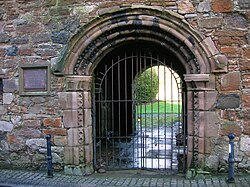Seagate Castle
| Seagate Castle | |
|---|---|
| Irvine, North Ayrshire, Scotland UK |
|

The castle entrance
|
|
| Coordinates | 55°37′00″N 4°40′14″W / 55.616804°N 4.670483°W |
| Site information | |
| Owner | Historic Scotland |
| Controlled by | Montgomery Clan |
| Open to the public |
On special occasions |
| Condition | Ruin |
| Site history | |
| Built | Sixteenth century |
| Materials | Stone |
Seagate Castle is a castle in North Ayrshire, in the town of Irvine, close to the River Irvine, Scotland. The castle was formerly a stronghold, a town house, and later a dower house of the Montgomery Clan. The castle overlooks the oldest street in Irvine, which was once the main route between the town and the old harbour at Seagatefoot, which by 1606, was useless and abandoned due to silting. The remains of the castle are protected as a category A listed building.
The first record of Irvine is in 1163, and the harbour at that time was near the sea-gait or Seagate, the castle being first built to protect it. Progressive silting was recorded by several early authors, who recorded that wind blowing the sand hindered the movement of ships, sometimes stranding them for several months. Irvine was created a Royal Burgh by King Robert II in 1372 and this castle is the last of the town's old civil and ecclesiastical buildings to survive, the Carmelite friary, tollbooth, chapel, bridge, and port having vanished without trace.
Benedict of Peterborough in 1184 records a castle of 'Hirun', which has been taken as referring to Irvine. The original, probably-wooden castle tower or motte, was therefore built some time before 1184, being rebuilt in stone in the 1360s and then remodelled and expanded by Hugh the 3rd Earl of Eglinton, around 1565.
In the twelfth century the castle of Irvine lay within the lordship of Cunninghame, which had been granted by David I to Hugh de Morville, Lord High Constable of Scotland. In 1196 the lordship passed from the de Morville family, through failure of male heirs, and then descended through various families, among whom were the Balliols. Robert the Bruce granted the lordship to Robert the Steward.
...
Wikipedia

